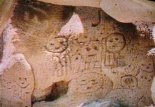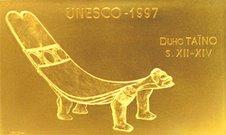Georgetown, Guyana (UCTP Taino News) – Three indigenous Arawak artists were featured in a recent multi-disciplinary arts exhibition at the famed Umana Yana cultural center in the Kingston section of Georgetown, Guyana.
Sponsored by the Ministry of Youth and Sport, the exhibition entitled "Guy Arts Fiesta" brought together visual, performing, and literary arts from June 29th through July 5th. The concept for this premier event was developed by Desmond Ali, one of Guyana's outstanding sculptor/painters hailing from the Lokono Arawak Nation.
The indigenous artists featured at the Umana Yana exhibition were also members of Lokono Arawak communities. These artists included two from Pakuri Arawak Territory (St. Cuthberts), Oswald Hussein and Roland Taylor, and one from the Pomeroon River region, Valentino Stull. All three are well established artists and have worked and exhibited outside of Guyana.
In attendance at the opening ceremony were various government officials, representatives of the Guyanese Organization of Indigenous Peoples (GOIP), and United Confederation of Taino People President Roberto Mucaro Borrero.
"It is an honor to have been invited here to the exhibition opening and see first hand these exemplary indigenous artists whose works are an inspiration to our communities especially our youth" stated Borrero.
The Umana Yana was built in 1972 and is a 55-foot high cone-shaped palm-thatched shelter constructed by members of the Wai Wai tribe. No nails were used in its construction and it shelters an area of approximately 460 square meters.
Umana Yana is an indigenous expression meaning "meeting place of the people."
Sponsored by the Ministry of Youth and Sport, the exhibition entitled "Guy Arts Fiesta" brought together visual, performing, and literary arts from June 29th through July 5th. The concept for this premier event was developed by Desmond Ali, one of Guyana's outstanding sculptor/painters hailing from the Lokono Arawak Nation.
The indigenous artists featured at the Umana Yana exhibition were also members of Lokono Arawak communities. These artists included two from Pakuri Arawak Territory (St. Cuthberts), Oswald Hussein and Roland Taylor, and one from the Pomeroon River region, Valentino Stull. All three are well established artists and have worked and exhibited outside of Guyana.
In attendance at the opening ceremony were various government officials, representatives of the Guyanese Organization of Indigenous Peoples (GOIP), and United Confederation of Taino People President Roberto Mucaro Borrero.
"It is an honor to have been invited here to the exhibition opening and see first hand these exemplary indigenous artists whose works are an inspiration to our communities especially our youth" stated Borrero.
The Umana Yana was built in 1972 and is a 55-foot high cone-shaped palm-thatched shelter constructed by members of the Wai Wai tribe. No nails were used in its construction and it shelters an area of approximately 460 square meters.
Umana Yana is an indigenous expression meaning "meeting place of the people."











